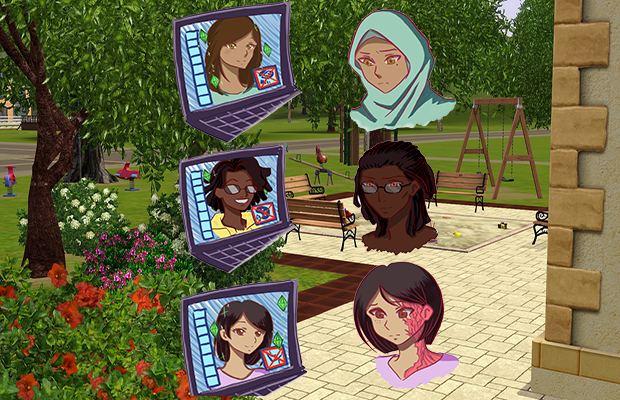The racist and normative life of Sims 4
Looking into the representations of race and body types in virtual reality.
It’s an uneventful evening. I’m sitting by a laptop as friends fiddle with the characteristics available on the screen to create a Sims 4 avatar. One friend, a caucasian female, does so with ease. We go from choosing their body type: slim; their hair colour: light brown; their eyes: black; and their outfit: jeans and a t-shirt.
When it came to making my avatar, we struggled. The Sims’ skin swatches did not come close to matching mine, and in the process of finding a premade Sim by looking up ‘Indian female’, results showed lacklustre, stereotypical depictions of what is deemed Indian or whitewashed avatars in traditional Indian wear. To add to this, I couldn’t even adjust the body size to match mine.
Growing up on real-life simulation games like the Sims, I never realised that I, a South Asian woman, was not represented accurately on a screen without a bindi. But now that I see my ideals are more aligned with western values, the fact that I see skinny bodies as “perfect”, and lighter skin as beautiful, is not only a reflection of the society I grew up in, but also a damaging emotion that is propagated by the participative media I surround myself with such as Sims.
Reddit users are amongst the gamers calling out the disturbingly realistic forms of racism in Sims 4. Diverse characters are whitewashed in urban living situations, and the random interactions Sims police have with young Black characters resemble America in all too familiar ways – false incarceration that disproportionately targets young people of colour (POC). The Sims 4’s ‘Get Together’ expansion pack allows users to engage in certain activities and push for certain stereotypes, a virtual echo chamber and narrative that we can hardly ignore outside this artificial world.
EA games, a US $1.04 billion dollar gaming company and the developer of Sims, told Forbes this year that in Sims 4, “We’re not really looking for realism, we’re looking more for believability.”
This kind of ‘believability’ is incredibly damaging when combined with the stereotypes inherent in Sims 4. While called out by mainstream media and film, the stark reality of racism and sexual harassment, is not represented ethically in some of our most popular, and widely-used video games. While I may have been too naive to notice it at 12, Sims 4 indeed fails to keep up with the body positivity movement, the Black Lives Matter movement and in general, propagating respect and acceptance of people outside the ‘norm’.
In games targeted at Asian markets, particularly ones like Blade and Soul and Wangzhe Rongyao (Strike of Kings), players face a microcosmic version of cultural appropriation inside this digital world when designing characters. The character’s clothes may be derived from South East Asian culture, but their faces are Caucasian. This racial favouritism towards Caucasian depictions in interactive games is very destructive. The fact that globalised game developers are profiting off this culture with little or no care for experience of diversity and multiplicity of views makes their content an echo chamber for toxic norms. They undermine self acceptance and confidence, in an increasingly capitalistic society that thrives and profits off self-doubt.
In 2014, Sims 4 sold more than 1.10 million copies worldwide. By the end of that year, gamers had played more hours than a decamillenium or 10,000 years. This game is isn’t just a past time, but an addiction that thousands of young minds spend their time on.
Sure, Sims may not inherently be programmed to judge other Sims on the basis of body type, but if young players are taught to accept a different shade of the colour of their skin, a different type of ‘idealised’ body in society within a virtual world they spend hours on, their perceptions of self and of difference will be inherently skewed as they go through life. EA’s definition of stark realities see creators pigeonholing people into certain body types and skin colours rather than leaving it open to moulding by the gamer — the original intent of the game itself.
When mainstream systems of entertainment and their creators fail to represent varied body types or diversity of background, users and analysts must find alternative means for enjoyment and social inclusion. The solution, then, is to address the lack of representation of South Asian designers employed in video game companies.
It is only through the active inclusion of diverse developers in teams of coders and designers that we will see a positive effect on the self-assurance of young players. This certainly isn’t an outcome of video games that is propagated enough currently by companies who are clearly blindsided by profits.




